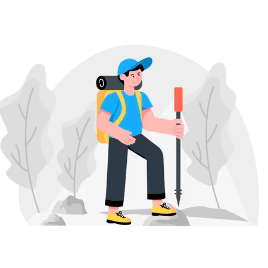

Located at an altitude of 2,610 meters, Phakding is an important village in the Khumbu region of Nepal. All visitors trekking to Mount Everest will pass through this charming village is in the Solukhumbu District, along the Dudh Koshi river which originates from one of the glaciers above 5,000 m near Gokyo Ri, and falls under Koshi Province of Nepal.
As Phakding lies in the Khumbu Pasang Lhamu Rural Municipality, its area code is the same as that of the rural municipality, +977-38 or simply 038. The postal code of the town isn’t specified. It is situated between Lukla and Namche Bazaar and the postal codes of these villages are 56010 and 56002, respectively.
Phakding is approximately 6.2 km from Lukla and 7.6 km from Namche Bazaar.
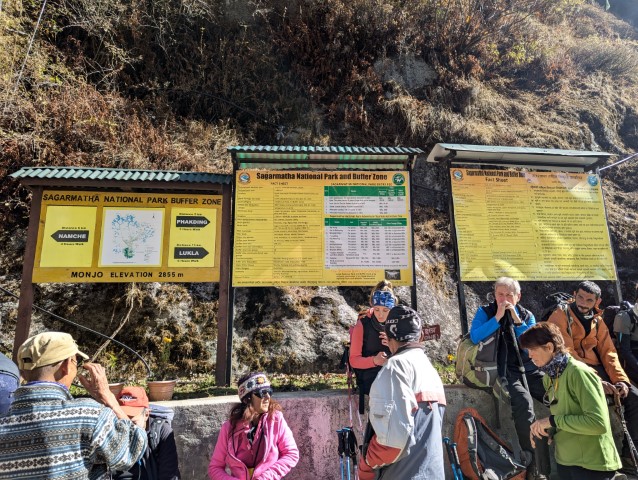
The village is surrounded by terraced fields, and has many suspension bridges, and traditional Sherpa homes.
Key Summary Table : Phakding
| Particulars | Details |
| Phakding Location | Khumbu region, Solukhumbu District, Nepal |
| Phakding Altitude | 2,610 meters (8,563 feet) |
| Best Time to Visit Phakding | Spring (March-May) and Autumn (September-November) for clear skies and moderate temperatures |
| How to Reach Phakding | 35-40 min flight from Kathmandu to Lukla, then a 3-4 hour trek; or a 2-3 day trek from Salleri/Phaplu |
| Main Attractions Around Phakding | Phakding Monastery (Rimijung Monastery), Dudh Koshi River, Scenic trails, Sherpa culture, Hillary Suspension Bridge |
| Local Experiences in Phakding | Stay in tea houses, try Sherpa cuisine (Sherpa stew, tsampa), shop for handmade crafts, visit monasteries |
| Historical Significance of Phakding | Important rest stop for Everest trekkers; part of historic Nepal-Tibet trade routes |
| Phakding Weather | Mild at lower elevations, colder at night; temperatures vary by season |
| Packing Essentials | Trekking boots, warm layers, gloves, sunscreen, sunglasses, sleeping bag (-10°C rated), trekking poles |
| Altitude Sickness Tips | Acclimatize properly, hydrate, ascend gradually, eat high-carb meals, rest if symptoms appear |
We believe that the best time to visit any destination, including Phakding, is whenever it is possible for you do to so. So, Trek Me Nepal can take you to Phakding any time of the year. But the most optimal seasons for trekking are spring and autumn.
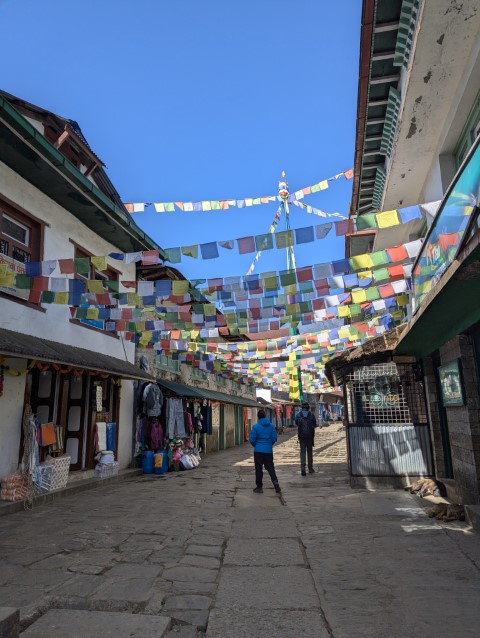

However, you can trek to the village at any season as long as you follow the tips from our seasoned guides. This a detailed breakdown of what weather to expect at Phakding throughout the year.
Although it is in the Everest region, Phakding isn’t situated at as high an altitude. Therefore the town’s weather isn’t as extreme as up north in the Khumbu region. The town has mild weather throughout the year.
Phakding Weather: Summary Table
| Season | Avg. Hot Days (°C) | Avg. Cold Nights (°C) | Avg. Daily Max (°C) | Avg. Daily Min (°C) |
| Spring | 18.3°C | -1.0°C | 15.3°C | 5.0°C |
| Summer | 21.0°C | 10.7°C | 19.0°C | 13.0°C |
| Autumn | 18.3°C | 2.3°C | 15.7°C | 6.7°C |
| Winter | 14.0°C | -8.7°C | 8.7°C | -3.7°C |
Note: (Meteoblue, 2025)
Phakding in Spring
| Month | Hot Days (°C) | Cold Nights (°C) | Mean Daily Max (°C) | Mean Daily Min (°C) |
| March | 16°C | -6°C | 12°C | -1°C |
| April | 19°C | -1°C | 15°C | 5°C |
| May | 20°C | 4°C | 17°C | 8°C |
Note: (Meteoblue, 2025)
Spring in Phakding sees a steady rise in temperatures from winter, with daily highs averaging 15.7°C and daily lows at 2.3°C. March remains chilly, with nights dropping to -6°C, but by May, nighttime temperatures become more manageable at 4°C. Days are increasingly warm, reaching 20°C in May.
The transition from winter to spring brings ideal trekking conditions with stable temperatures and clear skies, though higher altitudes may still have lingering snow. The warming trend makes spring one of the best seasons for exploring the region before the summer monsoon arrives.
As is usual for trekking, spring is the most popular season, so expect more people on the trails and in the tea houses. Accommodations can fill up quickly around this time, so it’s best to book your lodges and guides in advance.
Phakding In Summer
| Month | Hot Days (°C) | Cold Nights (°C) | Mean Daily Max (°C) | Mean Daily Min (°C) |
| June | 21°C | 9°C | 19°C | 12°C |
| July | 21°C | 12°C | 19°C | 14°C |
| August | 21°C | 11°C | 19°C | 13°C |
Note: (Meteoblue, 2025)
Despite being in the Everest region, Phakding has mild summers, with daytime highs of 19–21°C and cool nights of 9–14°C. The stable temperatures make trekking comfortable, though monsoon rains may affect trails.
Unlike the Everest Base Camp or the summit, where freezing conditions persist, this region offers a more accessible Himalayan adventure without extreme cold.
Phakding In Autumn
| Month | Hot Days (°C) | Cold Nights (°C) | Mean Daily Max (°C) | Mean Daily Min (°C) |
| September | 20°C | 9°C | 18°C | 12°C |
| October | 19°C | 1°C | 16°C | 6°C |
| November | 16°C | -3°C | 13°C | 2°C |
Note: (Meteoblue, 2025)
Autumn in Phakding sees a drop in temperatures, with average daily highs decreasing from 18°C in September to 13°C in November, while daily lows fall from 12°C to just 2°C. September remains relatively warm, but by October, nighttime temperatures start nearing freezing, and in November, they drop below zero.
Despite the cooling trend, daytime conditions stay comfortable for trekking, with highs between 13–18°C. This season offers clear skies and stable weather, making it one of the most popular time for trekking, though travelers should prepare for increasingly cold nights, especially from October onward.
Phakding In Winter
| Month | Hot Days (°C) | Cold Nights (°C) | Mean Daily Max (°C) | Mean Daily Min (°C) |
| December | 18°C | -7°C | 10°C | -2°C |
| January | 11°C | -10°C | 7°C | -5°C |
| February | 13°C | -9°C | 9°C | -4°C |
Note: (Meteoblue, 2025)
Winter in Phakding area is cold but not extreme compared to the higher altitudes of Everest Base Camp or the summit, with daily highs averaging 8.7°C and daily lows dropping to -3.7°C.
December is the mildest winter month, but temperatures drop further in January, the coldest month, with highs averaging 7°C and nights plummeting to -10°C. February sees a slight rise in temperatures, but nights remain well below freezing.
The extreme contrast between daytime warmth and frigid nights requires proper gear for trekkers. Despite the cold, clear skies and dry weather make trekking possible in winter too.
Phakding is a beautiful and cosy village in the Himalayas surrounded by breathtaking landscapes. The village sits along the Dudh Koshi River, which flows through a lush valley flanked by dense forests and terraced fields. The river’s clear turquoise waters and the sound of its gentle flow add to the area's atmosphere.
One of the standout features of Phakding is its rhododendron forests, which come alive in spring with vibrant blooms of red, pink, and white. The trails around Phakding are lined with these colorful trees, making treks even more enjoyable. They also provide a habitat for various bird species of the region.
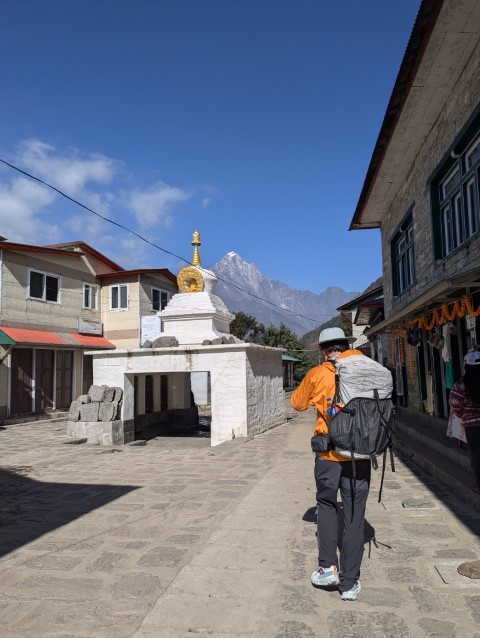
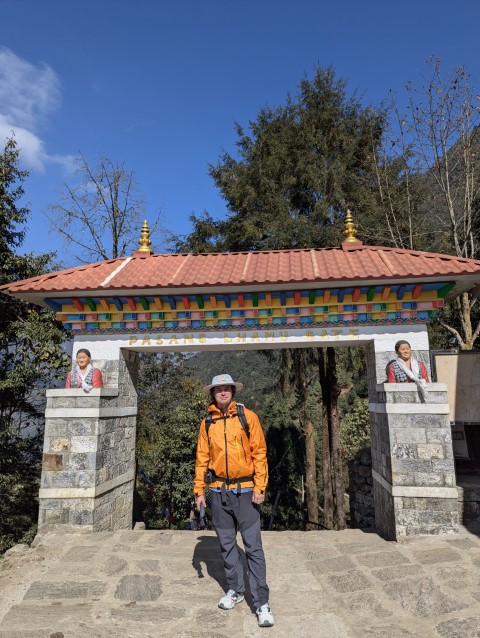

Visitors see panoramic views of several Himalayan peaks, including Kongde Ri (6,187 m). The sight of these peaks against the blue sky is a highlight for many visitors. However, for views of the more iconic peaks in the region, like Everest, Nuptse, Lhotse, Ama Dablam and Lobuche, you need to move further north.
Phakding is also known for the many nearby suspension bridges, the most famous of which is the Hillary Bridge. These bridges, which are often adorned with prayer flags, span the Dudh Koshi River and connect the village to nearby trails.
The village’s alpine meadows are another noteworthy attraction. These open spaces are dotted with grasses and wildflowers. Yaks are often seen grazing in these meadows.
Phakding lies within the Sagarmatha National Park (which is a UNESCO World Heritage Site), so trekkers passing through this village will encounter a variety of flora and fauna that are native to the park. From lush forests to alpine meadows, Phakding has it all.
The area around Phakding is home to a range of wildlife, some of which are rare and unique to the region. One of the most commonly spotted animals is the Himalayan Tahr, a goat-like creature that thrives in the rocky terrain. You might also come across the musk deer, known for its shy nature and distinctive scent glands.
A familiar sight in Phakding is the mountain yak, often seen grazing in the fields or carrying supplies for trekkers. These hardy animals are an integral part of life in the Himalayas.
Visitors are reminded to observe wildlife from a distance and avoid disturbing their natural habitat, as the park has strict conservation rules.
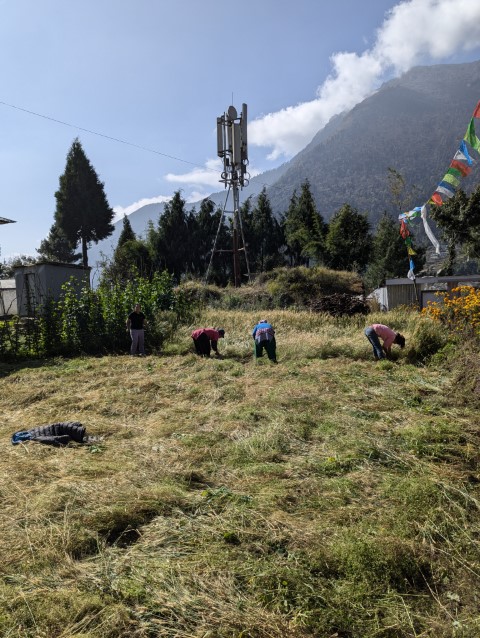
Birdwatchers will enjoy spotting species like the colorful Himalayan Monal (Nepal’s national bird), the Blood Pheasant, and the Golden Eagle.
The plant life in Phakding is just as impressive. The village is surrounded by rhododendron forests, which bloom in stunning shades of red, pink, and white during the spring. These forests are not only beautiful but also provide shelter for many birds and animals.
The alpine meadows are dotted with shrubs, grasses, and wildflowers that have adapted to the high-altitude environment. Along the banks of the Dudh Koshi River, you’ll find a mix of vegetation that thrives in the moist, fertile soil.
Something many trekkers today might not know about Phakding is that the city’s name is said to come from the fact that it had a large reserve of white micaceous clay. Phakding is used to supply this clay, which is used to whitewash houses.
Phakding is a small but culturally rich village in the Khumbu region, where the native Sherpa community lives. The Sherpas have preserved their traditions and way of life for generations. Their culture is deeply intertwined with Tibetan Buddhism, which influences everything from architecture to the town and the Everest region at large.
One of the most visible aspects of Sherpa culture in Phakding is the many monasteries (gompas) and stupas. These spiritual sites, often adorned with colorful prayer flags and intricate carvings, are places of worship and community gathering. The Rimijung Monastery is a peaceful spot where visitors can observe Buddhist rituals and learn about the spiritual practices of the Sherpa people.

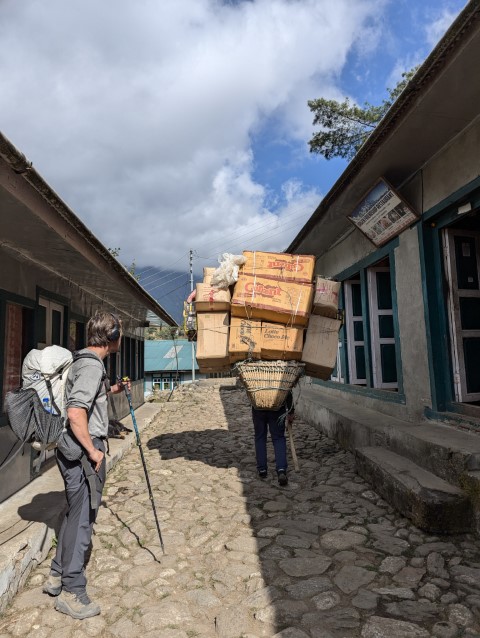
The Sherpas are renowned for their hospitality, which is evident in the numerous tea houses and lodges operated by local families. These establishments offer trekkers a place to rest and enjoy traditional Sherpa and Nepali food.
Popular dishes include Sherpa stew, a hearty soup made with potatoes, vegetables, and meat, and tsampa, a roasted barley flour that provides energy for long treks. For those craving Western flavors, these tea houses also serve international dishes like pasta, pizza, and pancakes. There are also some bars in the town that sell local drinks.
Craftsmanship is another important part of Sherpa culture, and this is also seen in Phakding. Locals create handmade items such as woolen clothing, jewelry, and traditional artifacts, which reflect their skill and creativity. Visitors often buy these as souvenirs.
The Sherpa community in Phakding is tightly knit, and their traditions are passed down through generations. From the way they build their homes to the festivals they celebrate, every aspect of life in Phakding is infused with cultural significance. This strong sense of identity makes the village a fascinating place to visit for anyone interested in learning about Himalayan culture.
The town of Phakding has much more to offer visitors. From its serene monasteries and iconic suspension bridges to its lush forests and stunning mountain views, the village is a destination worth exploring.
The Phakding Monastery is one of the first major monasteries you come across en route to Everest. It is known by many names, including Rimijung Monastery by the locals. About 10 monks and nuns reside and serve at the monastery, which is part of the Nyingma School of Tibetan Buddhism.
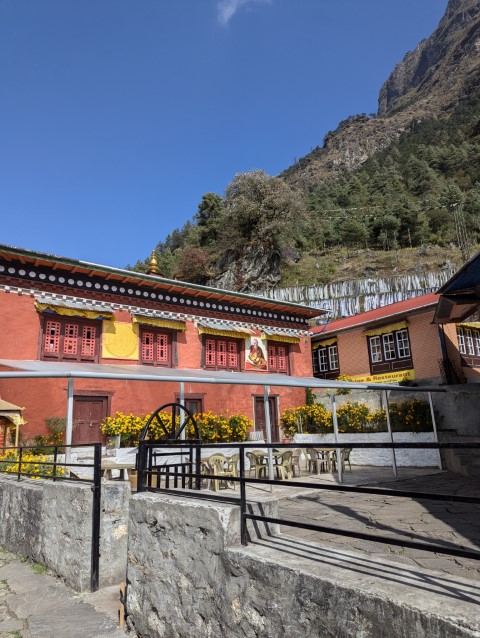
Phakding Monastery is a great spot for meditation. The monks even allow visitors to participate in the daily rituals, and visitors can join the meditation sessions.
One of the most recognisable features of Phakding is its suspension bridges over the Dudh Koshi River, especially the Hillary Suspension Bridge. Crossing these bridges, which are decorated with prayer flags, is a memorable experience and a great photo opportunity.
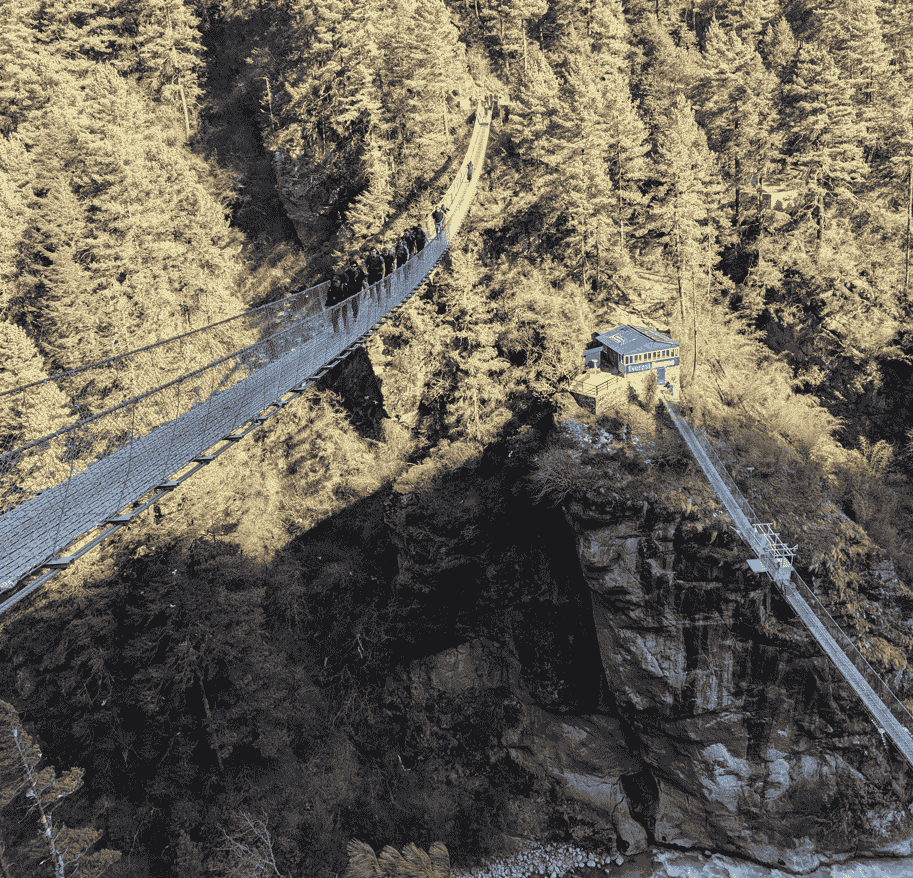
The Hillary Suspension Bridge, built in the early 2000s by Sir Edmund Hillary, connects Phakding to the northern Khumbu region, making it an essential part of the trek toward Namche Bazaar and Everest Base Camp.
Spanning the Dudh Koshi River, it was constructed to provide easier access for locals and trekkers in the remote region. The bridge is about 50 meters long, supported by steel cables and wooden planks. It is one of the first major landmarks trekkers encounter on their way to Namche Bazaar.
The Dudh Koshi River flows through Phakding, adding to the village’s beauty. The turquoise waters of the river contrast beautifully with the lush green forests and terraced fields. Walking along the riverbank is a peaceful way to enjoy the scenery and take in the sounds of nature.

Phakding is surrounded by dense rhododendron forests, which come alive with vibrant blooms during the spring months. These forests are not only visually stunning but also provide a habitat for various bird species. Trekking through these colorful forests is a highlight for many visitors.
The Sherpa villages (of which Phakding is one) offer a glimpse into the local way of life. Visitors can interact with the friendly Sherpa people, learn about their traditions, and enjoy the hospitality at the tea houses. These tea houses are a great place to rest, enjoy a meal, and experience the warmth of Sherpa culture.
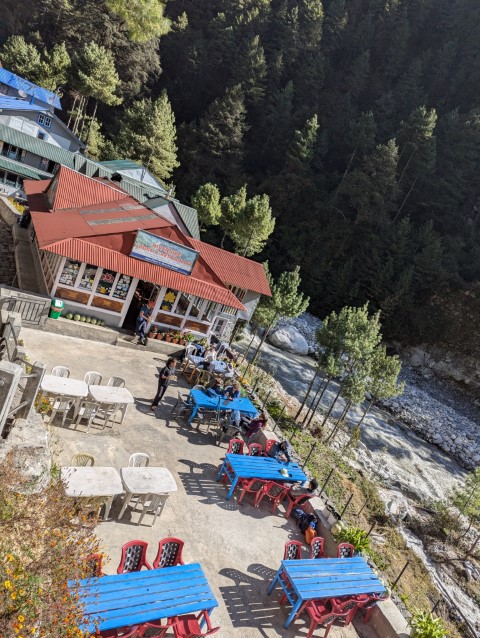
Exploring Farak Ri and Kongde Village: A Hidden Gem in the Everest Region
If you are trekking in the Everest region following the Three Passes Trek route, your journey typically continues from Phakding to Monjo. However, if you choose the Main Trekking Route, you will head toward Kongde (also spelled Konde), a scenic and less-traveled path that offers a unique perspective of the Himalayas.
That said, it does not mean you cannot visit Kongde while following the Three Passes route. You can still explore Farak Ri by combining both routes. From Phakding, you trek to Monjo, then continue to Namche Bazaar. From Namche, you proceed to Thame. All of these locations are part of the Three Passes Trek route of Everest Region.
After reaching Thame, you can follow the Main Trekking Route to Kongde. From Kongde, it is possible to hike to Farak Ri, a breathtaking viewpoint that offers panoramic views of Mt. Everest and surrounding peaks.
This combination allows you to experience the best of both routes - the cultural richness and challenging passes of the Three Passes Trek, along with the spectacular, less-crowded vistas from Kongde and Farak Ri.
Discovering Farak Ri (4,680 m / 15,354 ft)
From Kongde Village, you can hike to Farak Ri, a stunning viewpoint located north of Kongde within Sagarmatha National Park. At an altitude of 4,680 meters, Farak Ri is a hidden treasure that provides panoramic views of Mt. Everest and neighboring peaks such as Lhotse, Makalu, Cho Oyu, Thamserku, and Ama Dablam.
Often referred to as part of the Everest Panorama Trek, Farak Ri stands out as a place where Everest appears at eye level. This surreal view is far less crowded than popular viewpoints like Kala Patthar or Gokyo Ri, making it a peaceful and unforgettable experience.
See the map below to understand the route to Farak Ri in detail. The highlighted trail will help you plan your hike and know what to expect along the way.
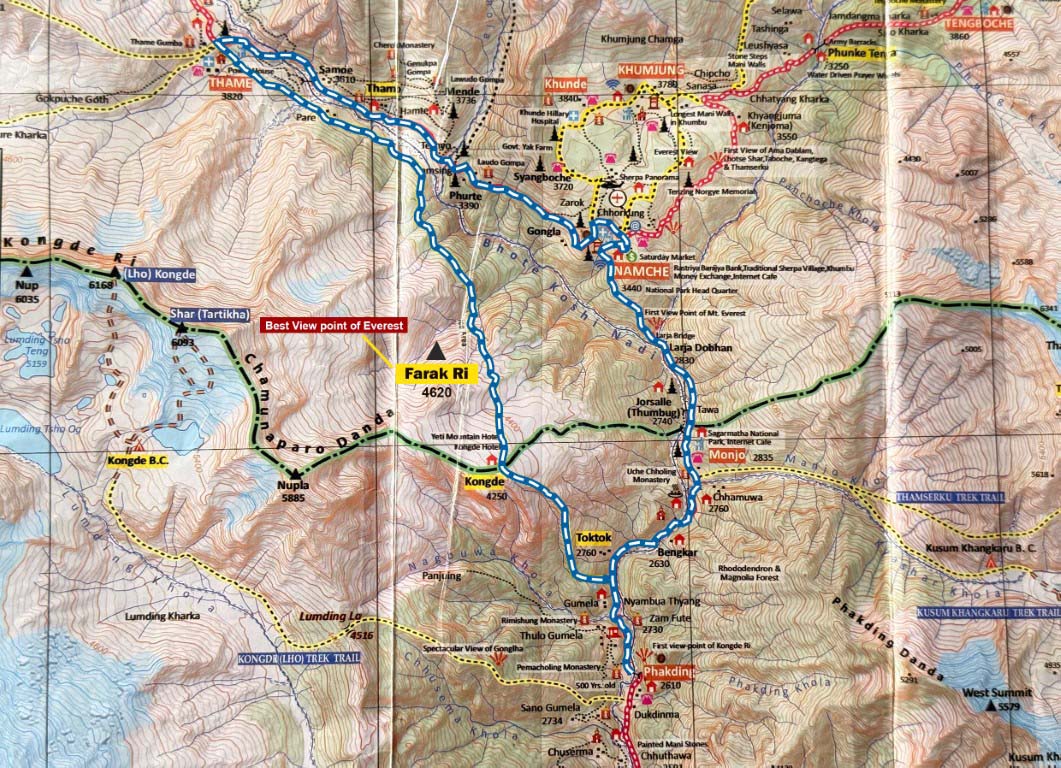
Phakding offers a range of accommodation options to suit different budgets and preferences. From basic tea houses to more comfortable lodges, the village provides a welcoming place for trekkers to rest and recharge. Most accommodations are run by local Sherpa families, ensuring a warm and authentic experience.
There are lots of accommodation options to choose from and many offer great services. Trekkers are advised to eat well and take care of their hygiene the best they can here as the options for accommodation, toilet, and food progressively get fewer and less luxurious as you travel further north.
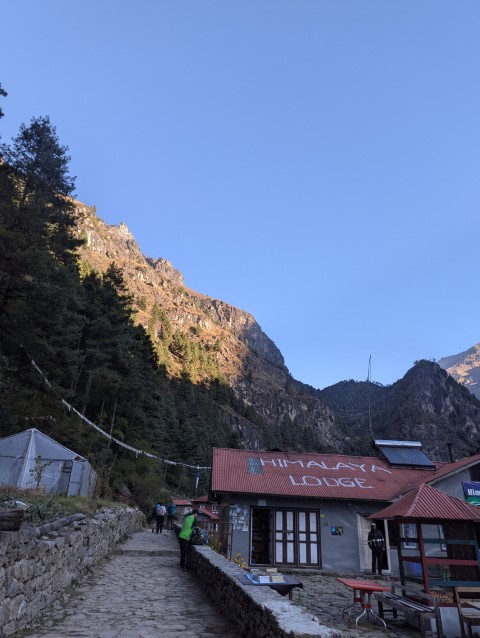
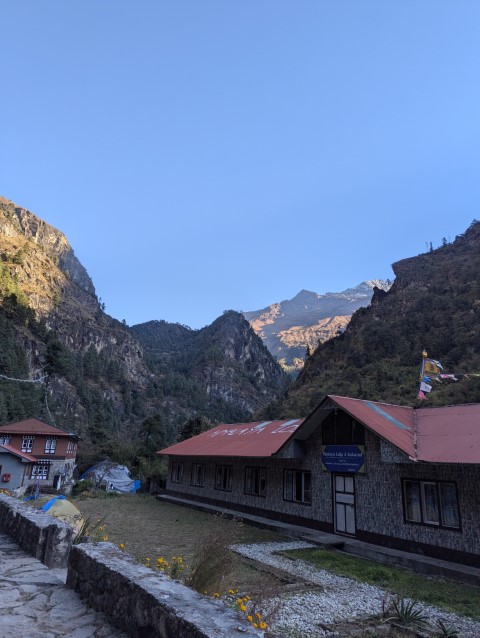
Phakding has electricity access, and the cell network is pretty good here, too. So, you should charge up your electronic devices here. Most hotels and lodges also have Wi-Fi.
Some popular and reliable lodges in Phakding are: Namaste Lodge Phakding, Shangrila Lodge, Mountain Resort Phakding, Snowland Lodge and Royal Sherpa Phakding.
Trekkers can immerse themselves in the local culture, explore the natural beauty of the Khumbu region, and engage in unique and fun activities in Phakding. From interacting with the Sherpa community to exploring scenic trails, here are some of the best local experiences and activities in Phakding:
Phakding has a rich history and culture. As a key stop on the Everest Base Camp trek, Phakding has played an important role in the development of trekking tourism in Nepal.
Beyond its natural beauty, the village offers a glimpse into the traditions and history of the Sherpa people, who have called this region home for centuries.
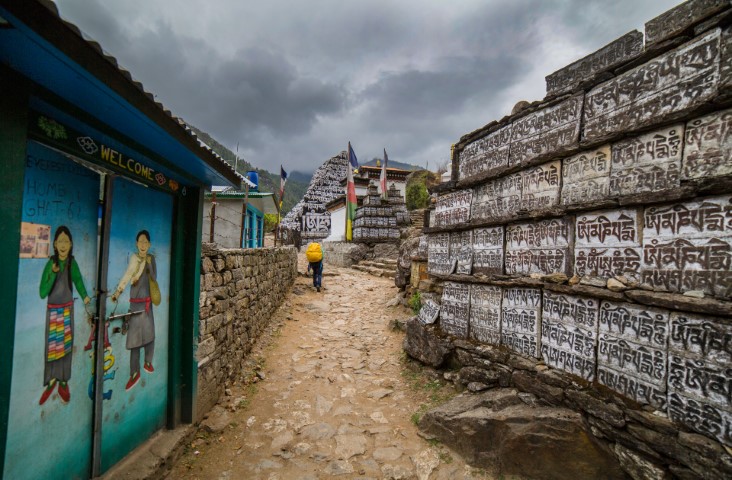
The Sherpa people reside in Phakding and the surrounding Khumbu region. Their culture is rooted in Tibetan Buddhism, which influences their daily lives, festivals, and architecture. The Sherpas are known for their resilience and adaptability in the harsh mountain environment, which has shaped their unique way of life.
Phakding has been a vital resting point for trekkers since the early days of Everest expeditions. The village’s location along the Dudh Koshi River made it a natural stop for climbers and trekkers heading to Everest Base Camp.
Over time, Phakding has developed into a hub for trekking tourism, with tea houses and lodges catering to visitors from around the world.
Phakding is known for its white micaceous clay, which locals use to whitewash their homes. This clay gives the village a distinctive appearance, with its bright white walls reflecting sunlight.
The use of this clay is a traditional practice that has been passed down through generations. It was also used to supply other regions of Nepal earlier on.
Tibetan Buddhism plays a central role in the cultural life of Phakding. The village is home to several small monasteries (gompas) and stupas. Prayer flags, mani stones (carved with Buddhist mantras), and prayer wheels are common sights in the town.
The Sherpa community in Phakding celebrates several traditional festivals tied to the Tibetan Buddhist calendar. Losar (Sherpa New Year) and Mani Rimdu (a festival of masked dances and rituals) are among the most important. These festivals display Sherpa culture, featuring music, dance, and communal feasts.
Phakding was historically part of the trade routes between Nepal and Tibet, especially given how close it is to Namche Bazaar, which was the trade hub of the region until a few years ago.
The village was a resting point for traders transporting goods like salt, wool, and grain across the Himalayas.
As part of the Sagarmatha National Park, Phakding plays a role in preserving the natural and cultural heritage of the Khumbu region. The village’s tea houses and lodges often emphasize sustainable practices, such as using solar power and minimizing waste.
This focus on conservation ensures that Phakding’s cultural and natural beauty is preserved for future generations.
Whether you’re passing through on your way to Everest Base Camp or spending a few days exploring the area, packing the right gear and understanding altitude sickness are crucial for a safe and enjoyable trek.
Phakding is a great place to start acclimatizing, but being prepared ensures you can fully enjoy the journey without unnecessary risks.
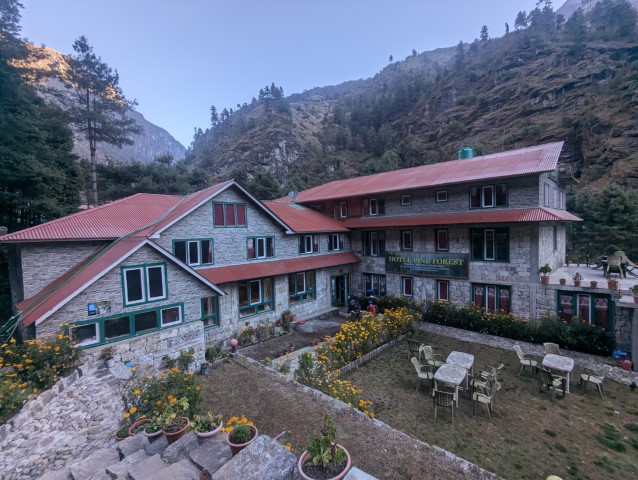
The nearest airport is in Lukla, a 35- to 40-minute flight from Kathmandu. From Lukla, it’s a 3 to 4-hour trek to Phakding. For those starting from Salleri or Phaplu, the trek to Phakding usually takes 2 to 3 days.
When visiting Phakding, it’s common courtesy to respect the local culture and traditions of the Sherpa community. The Sherpas' way of life reflects their spiritual beliefs in Tibetan Buddhism. By understanding and following local customs, you can ensure a more enjoyable experience.
Packing the right gear is essential for a comfortable and safe trek to Phakding. What you have packed for your Everest trip should suffice for Phakding too. You don’t need to bring anything specific to wear here.
However, do remember to pack at least 1 or 2 lighter shirts as Phakding, especially in late spring, summer and autumn, isn’t as cold as the upper Khumbu region.
Remember to bring:
Altitude sickness, also known as Acute Mountain Sickness (AMS), is a common concern for trekkers in the Everest region, including Phakding. While Phakding sits at a relatively moderate altitude, it’s still important to be aware of the risks, especially if you plan to ascend to higher elevations like Namche Bazaar or Everest Base Camp.
Altitude sickness occurs when your body struggles to adapt to lower oxygen levels at high altitudes. It can affect anyone, regardless of age or fitness level. Symptoms typically appear within 6-12 hours of ascending to a higher altitude and can range from mild to severe.
Symptoms of Altitude Sickness
Mild Symptoms:
Moderate to Severe Symptoms:
Severe altitude sickness can lead to life-threatening conditions like High Altitude Pulmonary Edema (HAPE) or High Altitude Cerebral Edema (HACE). These require immediate medical attention.
a) Ascend Slowly
Follow the golden rule of high-altitude trekking, ‘Climb high, sleep low.’ This means you can hike to a higher altitude during the day but return to a lower elevation to sleep. Do not increase your sleeping altitude by more than 300-500 meters per day once above 3,000 meters, if possible.
b) Stay Hydrated
Drink at least 3-4 liters of water daily to stay hydrated. Dehydration can worsen altitude sickness symptoms. Avoid alcohol and caffeine, as they can dehydrate you and impair your body’s ability to acclimatize.
c) Eat Well
Consume high-carbohydrate meals to maintain energy levels. Foods like rice, pasta, and potatoes are great options. Avoid heavy, greasy meals that can make you feel sluggish.
d) Rest and Acclimatize
Take rest days to allow your body to adjust. Phakding is a great place to acclimatize before heading to higher altitudes like Namche Bazaar. Avoid overexertion—walk at a steady, comfortable pace.
e) Acclimatization Tips
Phakding is more than just a stop on the Everest Base Camp trek. It’s the gateway to the Himalayas. Surrounded by lush forests, crossed by swaying suspension bridges, and home to serene monasteries, this charming village offers breathtaking mountain views and a chance to experience authentic Sherpa culture.
The peaceful sound of the Dudh Koshi River and the colorful prayer flags of the Hillary Suspension Bridge make Phakding a truly magical place to begin your adventure.
At Trek Me Nepal, we ensure your journey is safe, enjoyable, and unforgettable. Our carefully designed Everest Base Camp packages include expert guides, comfortable stays, and a dedicated team to support you every step of the way.
With us, the trek is not just about reaching the destination. It’s about cherishing every moment in the mountains.
If Phakding is calling, why not start your journey with Trek Me Nepal? Let’s make your Everest dream come true one step at a time.
Meteoblue. (2025). Climate & weather data for Phakding. Meteoblue. https://www.meteoblue.com/en/weather/historyclimate/climatemodelled/phakding_nepal_7996550
Trek Me Nepal Archives
Check out recent travel trends and news by Trek me Nepal
More Reasons Why Travellers Trust Us
Bipin Thapa
Operation Manager | Official Trekking Guide
Anyone who has trekked before knows trekking requires planning, and a deep understanding of the land. That is where Bipin Thapa Magar comes in. As the Operations Manager at Trek Me Nepal, he is the ba... Read More